
Share:   |
by Dan Eden
"A tree is identified by its fruit. Figs are never gathered from thornbushes, and grapes are not picked from bramble bushes." -Luke 6:44
Anesthesia
I'm going to tell you something that should make you very angry. I say -- should -- because what will likely happen is that you will decide to deal with this information by dismissing it as a "conspiracy theory" or you will soon become distracted by some other sensational news.
Sadly, the news media have made us all numb to the evils that go on around us. We see the faces and events on the displays in our homes, but they could just as well be actors in some global reality show. We have been conditioned -- anesthetized -- to squint our eyes and recede into our own private reality.
Meanwhile, some wide awake people are working hard to literally annihilate you and I. They are the bad trees and what you're about to read is an example of their "fruit".
In the early days of September 2011, two respected journalists, Yoichi Shimatsu [below] and Wayne Madsen [bottom of page] came out with a story that should spark outrage around the globe.
| The Messenger:
 Yoichi Shimatsu is a free lance journalist based in Hong Kong. He is former Editor of the Japan Times Weekly. Mr. Yoi is a former Tsinghua University lecturer. He's also Senior Advisor to The 4th Media, the English Website of the April Media Group. He's been regularly writing to several global media outlets including US, China and so on. He's been frequently sitting on CCTV News, Blue Ocean Network TV and other global media outlets in China, Hong Kong and other countries. Yoichi Shimatsu is a free lance journalist based in Hong Kong. He is former Editor of the Japan Times Weekly. Mr. Yoi is a former Tsinghua University lecturer. He's also Senior Advisor to The 4th Media, the English Website of the April Media Group. He's been regularly writing to several global media outlets including US, China and so on. He's been frequently sitting on CCTV News, Blue Ocean Network TV and other global media outlets in China, Hong Kong and other countries.
The story we are reporting was first posted on rense.com -- a web site known for conspiracy theories and controversial stories (which, more often than not, turn out to be true). Much of the story relied on sources that were not provided in the original article and would be unfamiliar to the ordinary person. We will attempt to show this material in context and validate (or not) the excellent reporting by Yoichi Shimatsu.
I encourage readers to take part in this story by finding facts to either support or debunk these horrific series of events. |
The Message:
We will show you the actual story, summarize where possible, and insert the actual source material supporting the claims made by the authors. This an on-going story -- something new for viewzone.
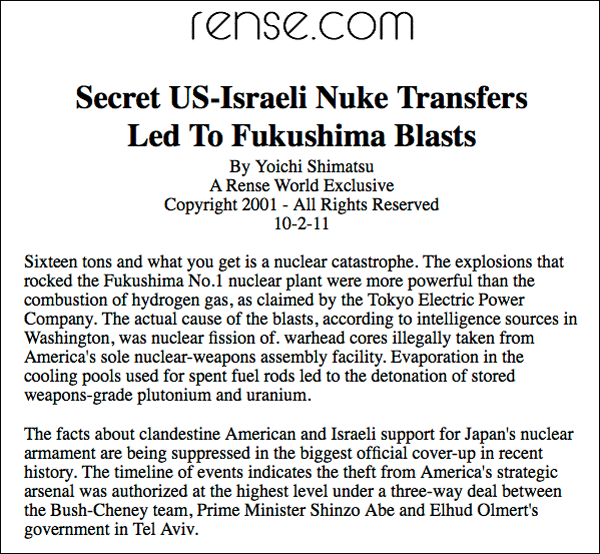
The article continues with details that you are encouraged to read for yourself. I've put together a timeline with supporting documents to make the story more real to you. But first...
The Cast of Characters
We'll explore what we know about various entities involved with this story.
- The Pantex Nuclear Facility -- where the outdated nuclear warheads were stored and then moved to the Port of Houston in the middle of a disabling strike at the facility by guards and security workers.
- Japanese Prime Minister Shinzo Abe -- who sought nuclear weapons for his country, contrary to Article 9 of the Japanese Constitution, as a rightful member of the strategic Pacific "Quad". [more]
- Vice President Dick Cheney -- who helped broker the transfer in return for Japan's involvement with the Quadrilateral Alliance, designed to check China's Pacific influence.
- President George W. Bush -- who formalized the deal at a private meeting with Japanese Prime Minister Abe at Camp David.
- Israel -- whose state owned global shipping company, Zim, took the warheads at the Port of Houston and subsequently negotiated payment with the Japanese in return for "leftovers" -- very old warheads needing core replenishment -- from the 16 ton Pantex haul.
- The Stuxnet Virus -- designed by the US and Israel for Iran's centrifuges, infected the computer system (Seimens) used by Fukushima-I and delayed opening emergency coolant valves immediately after the earthquake. This caused the recharging warhead cores ("pits") stored there to overheat and explode. How did the Israeli's accomplish this -- no problem. Magna BSP, an Israeli company, was in charge of the security at Fukushima! [source]
- "Tony" Carnaby -- the CIA contractor who knew about the radioactive shipment at Port Houston, was gunned down in an "accident" that most people think was set up by Mossad, Israel's intelligence agency.
- The Minot Nuclear Incident -- also happened in 2007. Several live warheads were "accidentally" mounted on an unguarded B-52 and flown over the US. It's not clear why they were moved or where they were destined. They were spotted by some airmen on the tarmac who alerted high command and secured them. Written off as a "misunderstanding" of orders, within one week 7 military personnel who loaded and flew the B-52 all died of "accidents" on and off the base.
Problems at the Nuclear Rest Home
|
Welcome to Pantex
The story begins with a facility called Pantex, located about 17 miles northeast of Amarillo, Texas. Pantex, America's nuclear warhead facility, sprawls over 16,000 acres of the Texas Panhandle outside Amarillo. Run for the Department of Energy (DOE) by a private contractor, Babcock & Wilson, the site also serves as a storage facility for warheads past their expiration date.
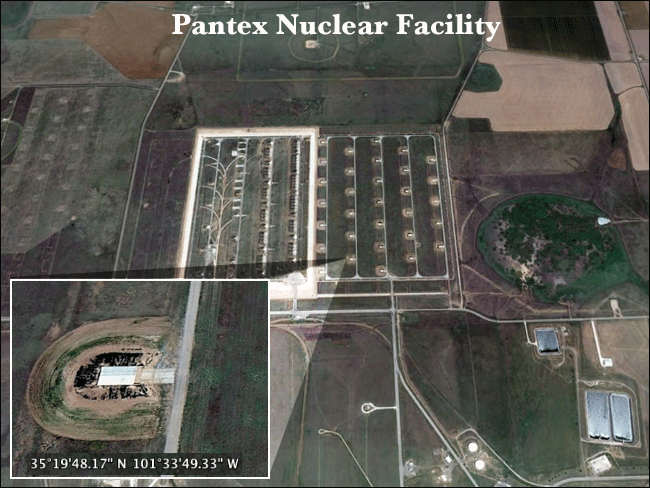
In the photo [above] you can see some of the older bunkers from WWII. The site has grown much since then. The 1989 shutdown of Rocky Flats, under community pressure in Colorado, forced the removal of those nuclear stockpiles to Pantex.[1]
The Pantex Plant's current functions include the fabrication of chemical high explosives; high-explosives development work in support of the design laboratories; and nuclear weapons assembly, disassembly, testing, quality assurance, repair, retirement, and disposal.
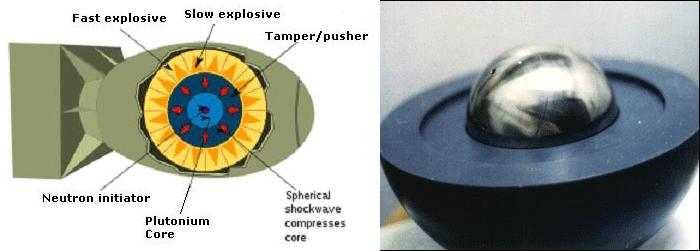
The most significant aspect of Pantex's current operation is its role as the primary site for storage of weapons plutonium in the United States. Capacity was increased in the mid-90's, and by 1999 the number had doubled to 12,067 plutonium pits (the term used for the plutonium cores) onsite -- about 60 tons. The site is currently allowed to store up to 20,000 pits.
|
2004: NNSA Computer Hacked, Pantex Info Stolen, Inside Job
In June 2004, a server at the Albuquerque office of the National Nuclear Security System was hacked.
Reported on June 13,2006 -- ALBUQUERQUE, N.M.:
"Hackers may have had the names, Social Security numbers and other personal data of 1,502 National Nuclear Security Administration workers since June 2004, more than a year before the computer break-in was discovered, the agency admitted Monday.
The information was stolen from an NNSA computer at Kirtland Air Force Base, and nearly half of the workers, employed by the federal agency and its contractors, are from New Mexico, according to an agency spokesman.
The theft was discovered in fall 2005 but did not become public until Friday at a congressional hearing."[2]
Personal information and security-clearance data for 11 federal employees and 177 contractors at Pantex were lifted. NNSA did not inform Energy Secretary Samuel Bodman or his deputy Clay Sell until three months after the security breach, indicating investigators suspected an inside job.
Having a list of personnel working at Pantex, along with specific personal information, would be an adventegeous first step in breaching the security of the facility.
Pantex has had its share of other problems, including safety concerns which were outlined in a report issued to then Secretary of the Department of Energy, Sam Bodman, on December 12, 2006:
"In one case, involving the disassembly of a missile warhead, technicians improperly used red vinyl tape to secure a crack in the high explosives surrounding the plutonium sphere of the hydrogen bomb. The use of the tape itself was not faulted, but technicians misread engineering instructions and caused an even bigger crack.
Federal safety inspectors found that the flawed operation "increased the opportunities for dropping all or part of the explosive during handling and hence increased the potential for a violent reaction," a finding that ran against assurances such a detonation was virtually impossible.
In the second case, technicians were extracting an assembly of high explosives and plutonium from the casing of a different missile warhead for servicing. Using a jackscrew to apply several thousand pounds of force to the explosives, technicians exceeded the allowable loads and over a three-day period violated strict safety protocols.[5]
Dan Swaim, BWX Technologies president at Pantex, acknowledged that both incidents broke safety rules and were unacceptable, but he said there was no risk of a disaster.
"No nuclear yield was possible," Swaim said, asserting the company maintains huge safety margins that preclude any potential for a conventional or nuclear explosion. "As a guy who works here every day, I want it to be darn safe."
2007:Pantex Guards Strike & 16 Tons of Old Warheads Moved
Strike at nuclear site stirs concerns
The Nation
May 24, 2007 | Ralph Vartabedian | Los Angeles Times Staff Writer
The Energy Department, facing concerns that a fractious strike by unionized guards is leaving a nuclear weapons plant in Texas vulnerable to a terrorist attack, is dispatching its top security official to conduct an urgent assessment at the site, officials said Wednesday.
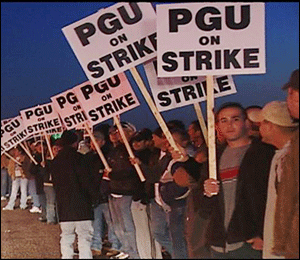 The strike by 524 highly trained nuclear weapons guards is entering its sixth week at the Energy Department's Pantex plant near Amarillo, the nation's primary site for servicing nuclear weapons and one of the most heavily guarded industrial plants.
The strike by 524 highly trained nuclear weapons guards is entering its sixth week at the Energy Department's Pantex plant near Amarillo, the nation's primary site for servicing nuclear weapons and one of the most heavily guarded industrial plants.
In response to the walkout, the Energy Department has reassigned supervisors, specially-trained bomb couriers and guards from other plants across the country to help protect the 25-square-mile facility, where fully assembled hydrogen bombs and thousands of components are stored in bunkers.
There are 210 replacement guards -- less than half the normal complement -- now at the site, according to William J. Desmond, chief of defense nuclear security for the Energy Department's National Nuclear Security Administration. He said the plant had eliminated vacations, training and low-priority duties to help cope with a smaller force.
"I am convinced that the Pantex site is secure," Desmond said.
But outside critics disagree. The Energy Department's top security officer, Glenn S. Podonsky, will go to Pantex next week to conduct a higher-level assessment.
In late April, Podonsky told the Senate Armed Services Committee that the plant site was well defended but that a long strike could erode security and strain the nation's entire nuclear weapons infrastructure.
Podonsky is expected to conduct performance exercises to assess how well the ad hoc guard force would respond to armed terrorists. A spokesman for Desmond said the special assessment was being conducted at his agency's request.
Desmond said he believed the Energy Department could weather the strike indefinitely. The striking guards' lost wages, he said, have saved the agency about $200,000, even though it has flown in replacement workers and put them up in hotels.
But Desmond's upbeat assessment is disputed by union and watchdog officials, who say security at the plant is deteriorating as the strike drags on.
Mike Stumbo, chief of the National Council of Security Police, said the strike had "absolutely" eroded security at the site, given that the supervisors are working up to 14-hour shifts, seven out of eight days, and are not familiar with Pantex's unusually stringent protocols. (Emphasis added)[3] |
The Transfer
The next part of the story comes by way of Wayne Madsen's excellent reporting on the event, including some more sad news about the security of America's nuclear warhead stockpile.
 Israel's nuclear smuggling network was key element in Carnaby murder in Houston
Israel's nuclear smuggling network was key element in Carnaby murder in Houston
By Wayne Madsen
(September 2011 release) Israel, working with deeply-embedded intelligence moles in the United States, including within the U.S. government and "off-the-books" intelligence front companies, has been pilfering spent U.S. nuclear fuel from American nuclear arms caches at a phenomenal rate over the last several years. U.S. and foreign intelligence sources have confirmed that much of the nuclear fuel has been shipped to Israel and other locations via the port of Houston.
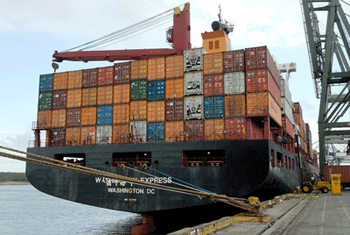 The illegal smuggling of spent highly-enriched uranium (HEU) and plutonium fuel from U.S. nuclear weapons facilities is the same outbound Houston shipping pipeline used by Bush-influenced Carlyle Group and the firm's front companies in Spain and France to ship precursor nerve gas chemicals to Saddam Hussein's Iraq in the 1980s, according to one Pentagon intelligence source.
The illegal smuggling of spent highly-enriched uranium (HEU) and plutonium fuel from U.S. nuclear weapons facilities is the same outbound Houston shipping pipeline used by Bush-influenced Carlyle Group and the firm's front companies in Spain and France to ship precursor nerve gas chemicals to Saddam Hussein's Iraq in the 1980s, according to one Pentagon intelligence source.
The nuclear smuggling is a major back story to a September 8 Government Accountability Office (GAO) report titled "Nuclear Nonproliferation: U.S. Agencies Have Limited Ability to Account for, Monitor, and Evaluate the Security of U.S. Nuclear Material Overseas." The most serious finding in the GAO report states:
"DOE [Department of Energy], NRC [Nuclear Regulatory Commission], and State are not able to fully account for U.S. nuclear material overseas that is subject to nuclear cooperation agreement terms because the agreements do not stipulate systematic reporting of such information, and there is no U.S. policy to pursue or obtain such information. U.S. nuclear cooperation agreements generally require that partners report inventory information upon request, however, DOE and NRC have not systematically sought such data. DOE and NRC do not have a comprehensive, detailed, current inventory of U.S. nuclear material -- including weapon-usable material such as highly enriched uranium (HEU) and separated plutonium -- overseas that includes the country, facility, and quantity of material. In addition, NRC and DOE could not fully account for the current location and disposition of U.S. HEU overseas in response to a 1992 congressional mandate. U.S. agencies, in a 1993 report produced in response to the mandate, were able to verify the location of 1,160 kilograms out of 17,500 kilograms of U.S. HEU estimated to have been exported. DOE, NRC, and State have established annual inventory reconciliations with five U.S. partners, but not the others it has transferred material to or trades with."
The report also states that a nuclear cooperation agreement between the United States and Israel was allowed to lapse. The GAO report also states: "DOE's Global Threat Reduction Initiative (GTRI) removes U.S. nuclear material from vulnerable facilities overseas but can only bring back materials that have an approved disposition pathway and meet the program's eligibility criteria." WMR has been informed that because of the amount of HEU and plutonium smuggled from the United States outside of "approved disposition pathways," there is no way for the United States to know exactly where HEU and plutonium has been distributed, especially to unauthorized end-users who have been using the spent nuclear material in violation of the nuclear non-proliferation treaty (NPT) or U.S. export control laws. Countries that fall into this category, according to our sources, include Japan, Israel, South Korea, North Korea, Saudi Arabia, India, Syria, Iran, Burma, Egypt, Turkey, Taiwan, and Pakistan.
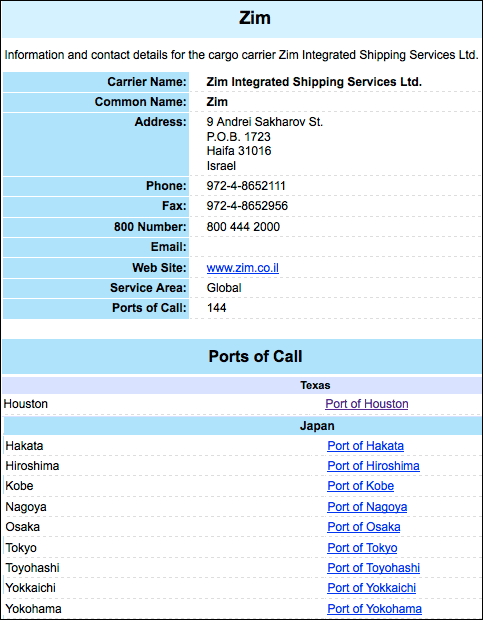
The major reason behind the nuclear material smuggling from the United States stems from Israel quietly re-establishing its global nuclear smuggling operations, rampant during the 1960s when it was working to acquire nuclear weapons. Israel's Dimona nuclear reactor capabilities have always been clouded in maximum secrecy but it is known that the facility suffered a major equipment failure in the 1990s that impacted on Israel's ability to re-process nuclear fuel.
The diminished capabilities of the Negev Nuclear Research Center prompted Israel, in the 1990s, to actively smuggle nuclear materials, including enriched plutonium, to Israel. The smuggling operations immediately became known to the CIA's Counterproliferation Division and its non-official cover (NOC) Brewster Jennings & Associates operation headed up by Valerie Plame Wilson. It was a major reason why Vice President Dick Cheney, his counsel Scooter Libby, State Department Undersecretary for Political Affairs (and President Obama's current envoy to Afghanistan and Pakistan) Marc Grossman, and others within the Bush administration exposed the Brewster Jennings operations.
Israel's search for replacement enriched plutonium hit pay-dirt when its intelligence service discovered that the Pantex nuclear facility near Amarillo, Texas, stores enriched plutonium fuel that is 99 percent pure plutonium that does not require reprocessing for another 60 to 90 years. Israel gained access to the classified details of the Pantex operation by tapping into classified government communication networks through the Israeli-owned communication company AMDOCS.
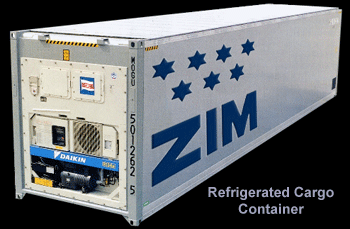 The Israelis discovered that only U.S. nuclear cores composed of plutonium alloys were ripe for theft at Pantex. The 99 percent plutonium fuel was more well-guarded. However, the older plutonium alloy cores were unstable and the shipment of the cores through the port of Houston required refrigerated containers to keep them cooler than 150 degrees. The Israelis used refrigeration trucks to move the cores through the port of Houston from Amarillo and into refrigeration containers loaded on board ships belonging to Zim-American Israeli Shipping Company, a firm with close links to the Mossad. The plutonium cores were shipped to Israel and Dimona.
The Israelis discovered that only U.S. nuclear cores composed of plutonium alloys were ripe for theft at Pantex. The 99 percent plutonium fuel was more well-guarded. However, the older plutonium alloy cores were unstable and the shipment of the cores through the port of Houston required refrigerated containers to keep them cooler than 150 degrees. The Israelis used refrigeration trucks to move the cores through the port of Houston from Amarillo and into refrigeration containers loaded on board ships belonging to Zim-American Israeli Shipping Company, a firm with close links to the Mossad. The plutonium cores were shipped to Israel and Dimona.
Roland "Tony" Carnaby (R.I.P.)
One individual who had the port of Houston under close scrutiny was CIA contractor/informant/source Roland "Tony" Carnaby. Carnaby had set up a number of video surveillance cameras at the port of Houston and routinely uploaded the stored videos from the camera units to his Macintosh computer. WMR has learned from intelligence sources that Carnaby possessed a major secret about the smuggling operation: much of the nuclear material being shipped through Houston by Israel, more than its needs, was being re-sold by Israel on the international black market.
On April 29, 2008, Carnaby was shot to death by two Houston police officers after what was reported to have been a high-speed chase by police. After he was killed, the Houston police took possession of Carnaby's Macintosh computer. WMR previously reported that Carnaby kept Israeli intelligence assets and agents under close scrutiny in Houston and that he had a strange encounter with an Israeli Consulate General official the evening before he was shot.
WMR also previously reported on Mossad's penetration of the Houston Police Department and the Harris County Sheriff's Office. Radiation detectors routinely scan containers at Houston for the presence of nuclear materials, hence, it was important for the Mossad to counteract Carnaby's security systems at the port.
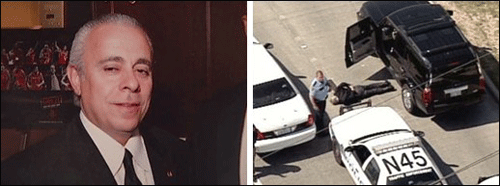
It is known that Carnaby [above] used a number of cell phones to dial into port video cameras to turn them on, stop them, and download captured video data. However, an Israeli firm, Orsus, was scheduled to begin installation of its own surveillance at the port, putting Carnaby's surveillance operations in jeopardy.
The financial backers of Orsus include ComSor Venture Fund LDC, a joint operation of Comverse Technology, which includes its subsidiary Verint Systems, and Soros Fund Management's Quantum Industrial Holdings Ltd. Other investors in Orsus include Israel's Koor Industries, the leading shareholder of Tadiran, the Israeli defense electronics firm; Cial Industries and Investment, an Israeli holding company; the Cedar Fund, an 'Israeli-related' venture capital firm; Israel Infinity Venture Capital Fund; and Poalim Capital Markets, a subsidiary of Bank Hapoalim, Israel's largest bank.
Carnaby was, reportedly, working with the FBI on the Israeli nuclear smuggling issue and the FBI office in Houston requested that the Houston police call off their chase of Carnaby. It was too late for Carnaby. He was marked for assassination by Mossad and its friends in Houston area law enforcement because of his knowledge of the nuclear smuggling program.
Israel was also concerned that Carnaby, a Lebanese-American with close ties to some of Lebanon's political groups opposed to Israel, might leak details of the operations to his Lebanese friends, information that would soon end up in the hands of Iranian and Syrian counter-intelligence.
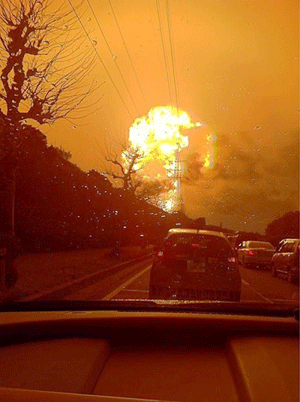 One of the countries that received re-sold American plutonium fuel from Israel was Japan. However, the Japanese soon discovered that the plutonium for which they were paying the Israelis top dollar was too old and provided only short-life usable nuclear weapons. Japan decided to go it alone on their nuclear weapons development but not before they planned to blow the whistle on the Israeli and American smuggling operation to the International Atomic Energy Agency (IAEA).
One of the countries that received re-sold American plutonium fuel from Israel was Japan. However, the Japanese soon discovered that the plutonium for which they were paying the Israelis top dollar was too old and provided only short-life usable nuclear weapons. Japan decided to go it alone on their nuclear weapons development but not before they planned to blow the whistle on the Israeli and American smuggling operation to the International Atomic Energy Agency (IAEA).
Before the Japanese could act, the super-quake struck Japan, along with the devastating tsunami. At that point in time, Israel and the Americans programmed their Stuxnet computer virus to trigger the nuclear catastrophe at Fukushima, the major site for Japan's nuclear weapons development program. Stuxnet, developed to disrupt Iran's nuclear program, is also effective against the nuclear power generation systems of other nations using standard supervisory control and data acquisition (SCADA) software, including the plutonium MOX fuel processing operations at Fukushima.
Stuxnet can be used to blackmail recipients of the smuggled plutonium material, including MOX fuel, into silence. The Fukushima disaster destroyed physical evidence of the Israeli smuggling operation to Japan. However, Japanese intelligence possesses other evidence of the Israeli smuggling operations.
The recent explosion at a MOX fuel plutonium processing facility at the French Marcoule nuclear power plant was a warning to France, courtesy of Stuxnet, not to support Palestine's bid for UN membership. It is not yet clear whether the MOX being used at Marcoule was developed from the unstable and old American plutonium cores smuggled and re-sold by Israel. However, U.S. intelligence has evidence that Israel has re-sold some of its stolen plutonium material to India in return for that nation providing Israel with missile systems and related technology.
 The disassociation of the CIA and FBI from Carnaby's murder in Houston was directly linked to the power of the Israel Lobby in Washington, which will stop at nothing to ensure that Israeli crimes and intelligence activities in the United States remain unexposed and unpunished.
[source, illustrations added]
The disassociation of the CIA and FBI from Carnaby's murder in Houston was directly linked to the power of the Israel Lobby in Washington, which will stop at nothing to ensure that Israeli crimes and intelligence activities in the United States remain unexposed and unpunished.
[source, illustrations added]
 Wayne Madsen Wayne Madsen, author of the story above, is a Washington, DC-based investigative journalist, author and syndicated columnist. He has been a frequent political and national security commentator on Fox News and has also appeared on ABC, NBC, CBS, PBS, CNN, BBC, Al Jazeera, and MS-NBC. Madsen has taken on Bill O'Reilly and Sean Hannity on their television shows. He has been invited to testifty as a witness before the US House of Representatives, the UN Criminal Tribunal for Rwanda, and an terrorism investigation panel of the French government. As a U.S. Naval Officer, he managed one of the first computer security programs for the U.S. Navy. He subsequently worked for the National Security Agency, the Naval Data Automation Command, Department of State, RCA Corporation, and Computer Sciences Corporation. Madsen is a member of the Society of Professional Journalists (SPJ), Association for Intelligence Officers. |
Cheney's "Man" In Charge Of Pantex
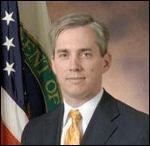
Throughout the Pantex caper, from the data theft to smuggling operation, Bush and Cheney's point man for nuclear issues was DoE Deputy Director Clay Sell, a lawyer born in Amarillo and former aide to Panhandle district Congressman Mac Thornberry. Sell served on the Bush-Cheney transition team and became the top adviser to the President on nuclear issues. At DoE, Sell was directly in charge of the U.S. nuclear weapons complex, which includes 17 national laboratories and the Pantex plant. (Another alarm bell: Sell was also staff director for the Senate Energy subcommittee under the late Sen. Ted Stevens of Alaska, who died in a 2010 plane crash.) -rense.com
Radiation Scanning for Incoming Cargo Only
How easy was it to move radioactive material through the Port of Houston? In fact, according to their own Security Report of 2007, they only just installed radiation detectors and only scan arriving cargo as it departs the port's terminals.
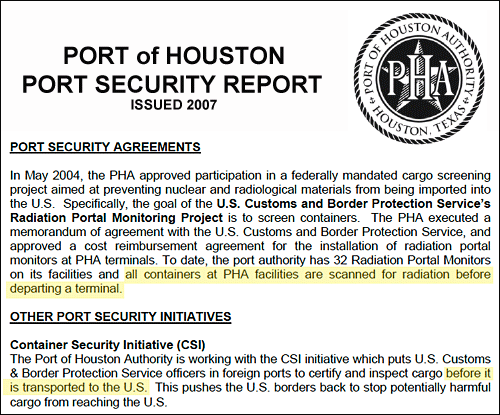


E-Mail Comments
COMMENTS:







 Yoichi Shimatsu is a free lance journalist based in Hong Kong. He is former Editor of the Japan Times Weekly. Mr. Yoi is a former Tsinghua University lecturer. He's also Senior Advisor to The 4th Media, the English Website of the April Media Group. He's been regularly writing to several global media outlets including US, China and so on. He's been frequently sitting on CCTV News, Blue Ocean Network TV and other global media outlets in China, Hong Kong and other countries.
Yoichi Shimatsu is a free lance journalist based in Hong Kong. He is former Editor of the Japan Times Weekly. Mr. Yoi is a former Tsinghua University lecturer. He's also Senior Advisor to The 4th Media, the English Website of the April Media Group. He's been regularly writing to several global media outlets including US, China and so on. He's been frequently sitting on CCTV News, Blue Ocean Network TV and other global media outlets in China, Hong Kong and other countries.

 The strike by 524 highly trained nuclear weapons guards is entering its sixth week at the Energy Department's Pantex plant near Amarillo, the nation's primary site for servicing nuclear weapons and one of the most heavily guarded industrial plants.
The strike by 524 highly trained nuclear weapons guards is entering its sixth week at the Energy Department's Pantex plant near Amarillo, the nation's primary site for servicing nuclear weapons and one of the most heavily guarded industrial plants. Israel's nuclear smuggling network was key element in Carnaby murder in Houston
Israel's nuclear smuggling network was key element in Carnaby murder in Houston The illegal smuggling of spent highly-enriched uranium (HEU) and plutonium fuel from U.S. nuclear weapons facilities is the same outbound Houston shipping pipeline used by Bush-influenced Carlyle Group and the firm's front companies in Spain and France to ship precursor nerve gas chemicals to Saddam Hussein's Iraq in the 1980s, according to one Pentagon intelligence source.
The illegal smuggling of spent highly-enriched uranium (HEU) and plutonium fuel from U.S. nuclear weapons facilities is the same outbound Houston shipping pipeline used by Bush-influenced Carlyle Group and the firm's front companies in Spain and France to ship precursor nerve gas chemicals to Saddam Hussein's Iraq in the 1980s, according to one Pentagon intelligence source. The Israelis discovered that only U.S. nuclear cores composed of plutonium alloys were ripe for theft at Pantex. The 99 percent plutonium fuel was more well-guarded. However, the older plutonium alloy cores were unstable and the shipment of the cores through the port of Houston required refrigerated containers to keep them cooler than 150 degrees. The Israelis used refrigeration trucks to move the cores through the port of Houston from Amarillo and into refrigeration containers loaded on board ships belonging to Zim-American Israeli Shipping Company, a firm with close links to the Mossad. The plutonium cores were shipped to Israel and Dimona.
The Israelis discovered that only U.S. nuclear cores composed of plutonium alloys were ripe for theft at Pantex. The 99 percent plutonium fuel was more well-guarded. However, the older plutonium alloy cores were unstable and the shipment of the cores through the port of Houston required refrigerated containers to keep them cooler than 150 degrees. The Israelis used refrigeration trucks to move the cores through the port of Houston from Amarillo and into refrigeration containers loaded on board ships belonging to Zim-American Israeli Shipping Company, a firm with close links to the Mossad. The plutonium cores were shipped to Israel and Dimona. One of the countries that received re-sold American plutonium fuel from Israel was Japan. However, the Japanese soon discovered that the plutonium for which they were paying the Israelis top dollar was too old and provided only short-life usable nuclear weapons. Japan decided to go it alone on their nuclear weapons development but not before they planned to blow the whistle on the Israeli and American smuggling operation to the International Atomic Energy Agency (IAEA).
One of the countries that received re-sold American plutonium fuel from Israel was Japan. However, the Japanese soon discovered that the plutonium for which they were paying the Israelis top dollar was too old and provided only short-life usable nuclear weapons. Japan decided to go it alone on their nuclear weapons development but not before they planned to blow the whistle on the Israeli and American smuggling operation to the International Atomic Energy Agency (IAEA). The disassociation of the CIA and FBI from Carnaby's murder in Houston was directly linked to the power of the Israel Lobby in Washington, which will stop at nothing to ensure that Israeli crimes and intelligence activities in the United States remain unexposed and unpunished.
[
The disassociation of the CIA and FBI from Carnaby's murder in Houston was directly linked to the power of the Israel Lobby in Washington, which will stop at nothing to ensure that Israeli crimes and intelligence activities in the United States remain unexposed and unpunished.
[ Wayne Madsen, author of the story above, is a Washington, DC-based investigative journalist, author and syndicated columnist. He has been a frequent political and national security commentator on Fox News and has also appeared on ABC, NBC, CBS, PBS, CNN, BBC, Al Jazeera, and MS-NBC. Madsen has taken on Bill O'Reilly and Sean Hannity on their television shows. He has been invited to testifty as a witness before the US House of Representatives, the UN Criminal Tribunal for Rwanda, and an terrorism investigation panel of the French government. As a U.S. Naval Officer, he managed one of the first computer security programs for the U.S. Navy. He subsequently worked for the National Security Agency, the Naval Data Automation Command, Department of State, RCA Corporation, and Computer Sciences Corporation. Madsen is a member of the Society of Professional Journalists (SPJ), Association for Intelligence Officers.
Wayne Madsen, author of the story above, is a Washington, DC-based investigative journalist, author and syndicated columnist. He has been a frequent political and national security commentator on Fox News and has also appeared on ABC, NBC, CBS, PBS, CNN, BBC, Al Jazeera, and MS-NBC. Madsen has taken on Bill O'Reilly and Sean Hannity on their television shows. He has been invited to testifty as a witness before the US House of Representatives, the UN Criminal Tribunal for Rwanda, and an terrorism investigation panel of the French government. As a U.S. Naval Officer, he managed one of the first computer security programs for the U.S. Navy. He subsequently worked for the National Security Agency, the Naval Data Automation Command, Department of State, RCA Corporation, and Computer Sciences Corporation. Madsen is a member of the Society of Professional Journalists (SPJ), Association for Intelligence Officers.